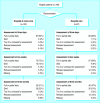Randomised controlled trial of effectiveness of Leicester hospital at home scheme compared with hospital care
- PMID: 10591717
- PMCID: PMC28299
- DOI: 10.1136/bmj.319.7224.1542
Randomised controlled trial of effectiveness of Leicester hospital at home scheme compared with hospital care
Abstract
Objective: To compare effectiveness of patient care in hospital at home scheme with hospital care.
Design: Pragmatic randomised controlled trial.
Setting: Leicester hospital at home scheme and the city's three acute hospitals.
Participants: 199 consecutive patients referred to hospital at home by their general practitioner and assessed as being suitable for admission. Six of 102 patients randomised to hospital at home refused admission, as did 23 of 97 allocated to hospital.
Intervention: Hospital at home or hospital inpatient care.
Main outcome measures: Mortality and change in health status (Barthel index, sickness impact profile 68, EuroQol, Philadelphia geriatric morale scale) assessed at 2 weeks and 3 months after randomisation. The main process measures were service inputs, discharge destination, readmission rates, length of initial stay, and total days of care.
Results: Hospital at home group and hospital group showed no significant differences in health status (median scores on sickness impact profile 68 were 29 and 30 respectively at 2 weeks, and 24 and 26 at 3 months) or in dependency (Barthel scores 15 and 14 at 2 weeks and 16 for both groups at 3 months). At 3 months' follow up, 26 (25%) of hospital at home group had died compared with 30 (31%) of hospital group (relative risk 0. 82 (95% confidence interval 0.52 to 1.28)). Hospital at home group required fewer days of treatment than hospital group, both in terms of initial stay (median 8 days v 14.5 days, P=0.026) and total days of care at 3 months (median 9 days v 16 days, P=0.031).
Conclusions: Hospital at home scheme delivered care as effectively as hospital, with no clinically important differences in health status. Hospital at home resulted in significantly shorter lengths of stay, which did not lead to a higher rate of subsequent admission.
Comment in
-
Evaluation of hospital at home scheme. Despite study's positive findings the scheme faces financial constraints.BMJ. 2000 Apr 15;320(7241):1077-8. BMJ. 2000. PMID: 10764381 Free PMC article. No abstract available.
-
Evaluation of hospital at home scheme. Another study found that patients prefer home care to hospital care.BMJ. 2000 Apr 15;320(7241):1078. BMJ. 2000. PMID: 10836812 No abstract available.
References
-
- Shepperd S, Iliffe S. The effectiveness of hospital at home compared to in-patient hospital care. (Protocol for Cochrane Library) In: Bero L, Grilli R, Grimshaw J, Oxman A, editors. Cochrane Library. Oxford: Update Software; 1998.
-
- Knowelden J, Westlake L, Wright KG, Clarke SJ. Peterborough hospital at home: an evaluation. J Public Health Med. 1991;13:182–188. - PubMed
Publication types
MeSH terms
LinkOut - more resources
Full Text Sources

